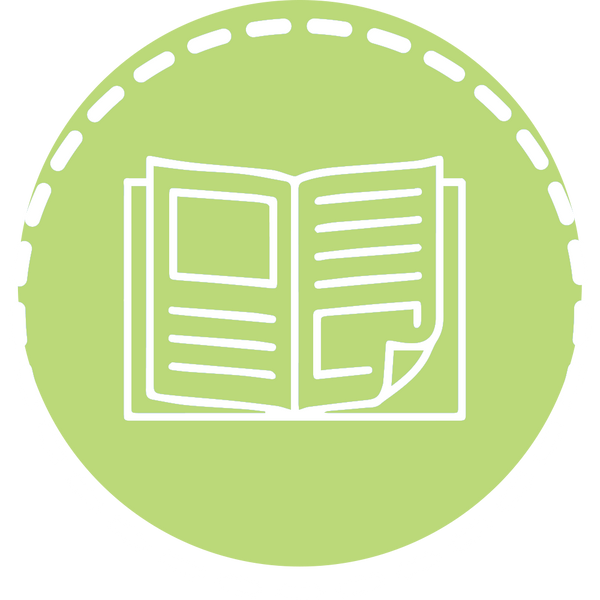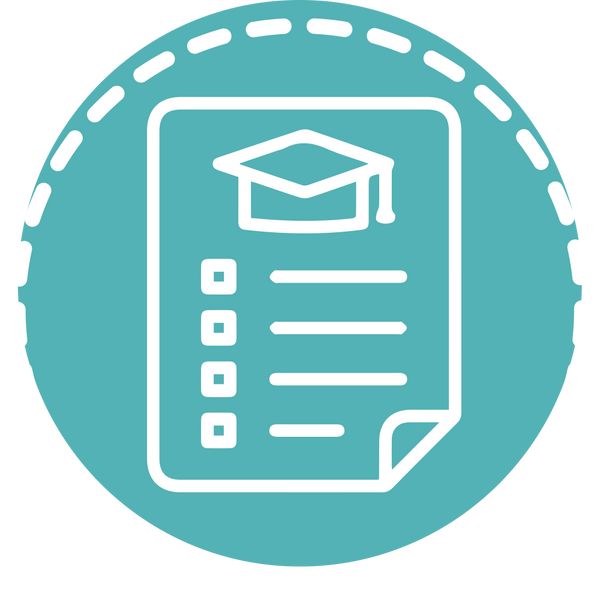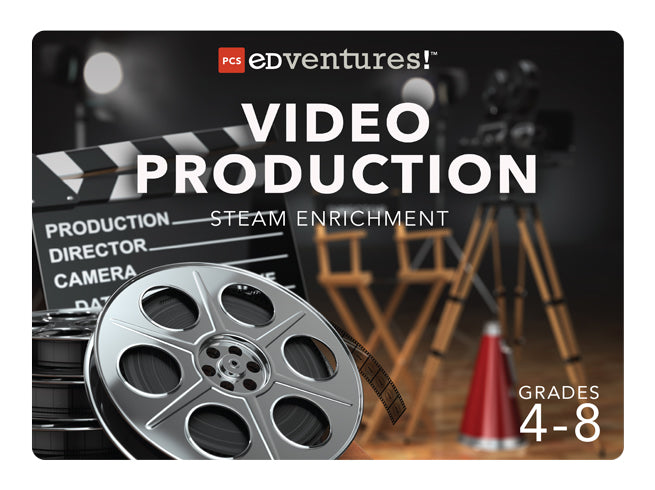
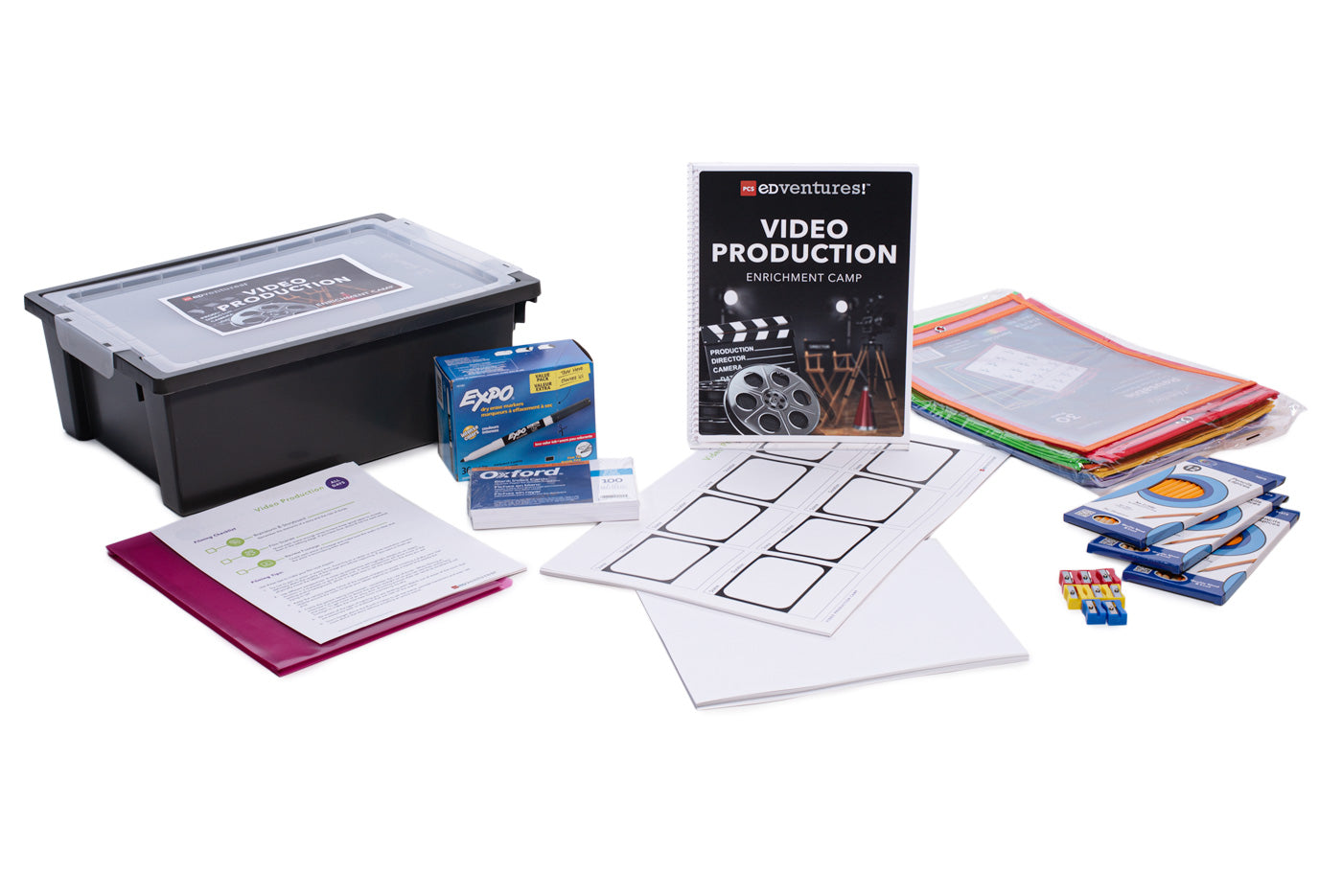
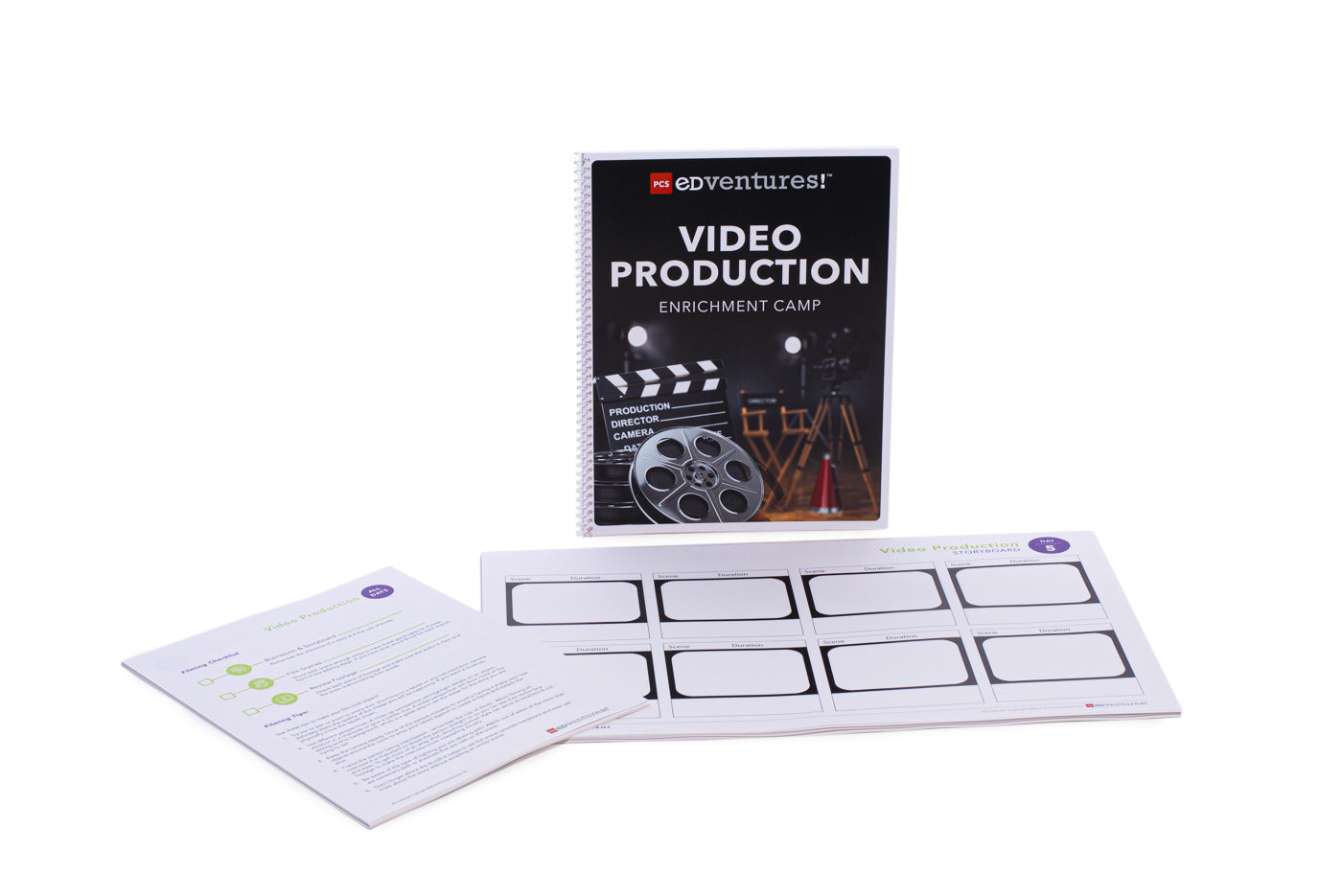
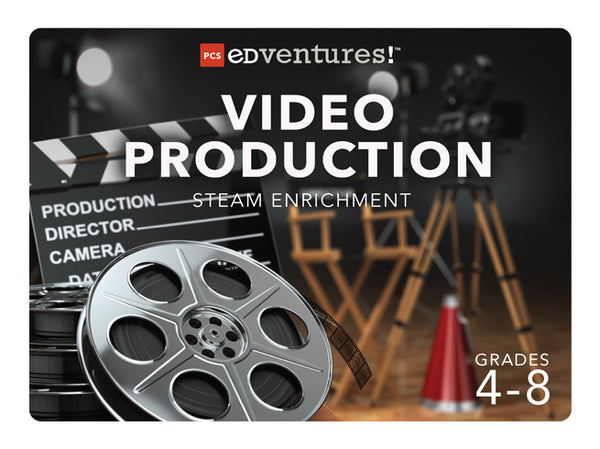
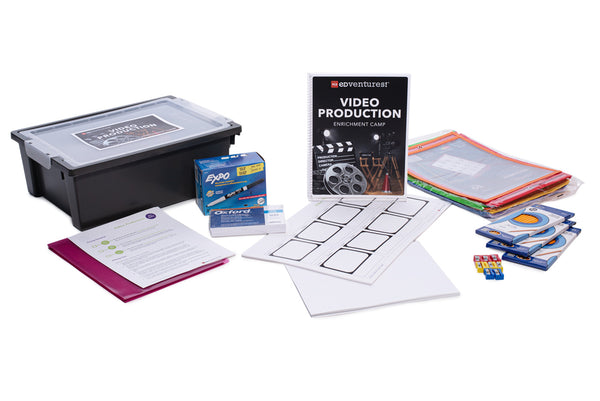
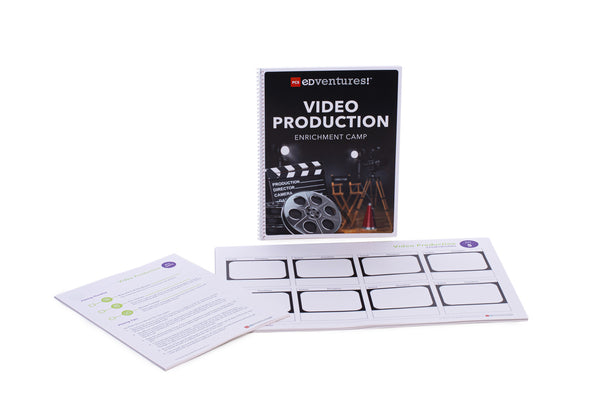



Video Production
- Price
- 415 USD
Lights, Camera, Action!
As the digital age continues to advance, it’s never been easier to learn the art of filmmaking. Developed around tablets and free editing software, Video Production empowers learners with technical skills in filming and video editing while exploring the historical significance of film and the unique elements of storytelling..
From collaborative storyboarding and the rule of thirds to lighting and audio, each scaffolded activity builds upon the previous day, culminating in a final film project that movie makers proudly share at the end of the program. Bring STEM and technological literacy to the silver screen in this extraordinary filmmaking introduction.
Grades: 4-8
Students: Up to 30
Contact Hours: 12+
Subject Targets:
Technology, Art/STEAM, English Language Arts
Reusability and Expansion:
- Very Few Consumables: This product includes some items that may need to be replaced from time to time. See materials tab for details.
Settings & Tech Requirements
Recommended Settings:
- Summer Camps
- Classrooms
- Out-of-School Time Programs
- Home Learning
Tech requirements:
- 6 compatible devices (1 per group of up to 5 students)
- The Canva video editing platform is compatible with Internet-connected tablets (Android or iPad), Chromebooks or computers.
Curriculum Topics
Each Activity Includes:
- Schedule
- Opening & Closing Discussion
- Step-By-Step Activity Instructions
- Topic Background Information & Vocabulary
- Materials List
Curriculum Topics:
- Daily Lesson Titles
- Storytelling & Film
- Silent Films & Genres
- Interviews & Reporting
- Documentaries & Composition
- Storyboarding
- Intro to Filming
- Film Framing and Experimentation
- Film to Edit & B-Roll
- Intro to Editing
- Source & Sync Audio Files
- Final Edits & Credits
- Film Festival
Professional Development
Product Orientation:
- Half-hour free webinar orientation for purchases of $500+
- One-hour free webinar orientation for purchases of $1000+
- Additional training available for purchase
Materials
Complete Program Includes:
Video Production comes with all of the supplies needed for 30 students to complete 12 one-hour activities:
- Instructor Guide: 1
- Printed Student Pages: 30 sets
- #2 Pencils (12 Pack): 3
- Dry Erase Markers: 31
- Dry Erase Page Pockets: 31
- Gratnell Tray: 1
- Index Cards: 100
- Pencil Sharpeners: 12
- Sheets of White Paper: 31
- Access to the Digital Resource Portal
Curriculum Print & Digital Includes:
- Instructor Guide: 1
- Printed Student Pages: 30 sets
- Access to the Digital Resource Portal
Standards & Alignment
Habits of Mind:
16 thinking habits developed by Art Costa and Bena Kallick to empower students to succeed in a 21st-century learning environment.
- Thinking and Communicating with Clarity and Precision
- Applying Past Knowledge to New Situations
- Engage effectively in a range of collaborative discussions
(one-on-one, in groups, and teacher-led) with diverse partners on grade
4-8 topics, texts, and issues, building on others' ideas and expressing
their own clearly. - Creating, Imagining, Innovating
- Thinking Interdependently
- Creating, Imagining, Innovating
21st Century Skills:
A set of widely-applicable abilities essential for success in the information age.
- Communication and Collaboration
- Information, Media, and Technology Literacy
- Social and Cross-Cultural Skills
- Applying Past Knowledge to New Situations
- Thinking Interdependently
- Creating, Imagining, Innovating
- Initiative and Self-Direction
- Flexibility and Adaptability
© 2019 Battelle for Kids. battelleforkids.org. All Rights Reserved. Battelle for Kids was not involved in the production of this product and does not endorse it.
Common Core State Standards for English Language Arts:
- CCSS.ELA-LITERACY.SL.4.1 Engage effectively in a range of collaborative discussions (one-on-one, in groups, and teacher-led) with diverse partners on grade 4 topics and texts, building on others’ ideas and expressing their own clearly.
- CCSS.ELA-LITERACY.SL.8.1 Engage effectively in a range of collaborative discussions (one-on-one, in groups, and teacher-led) with diverse partners on grade 4-8 topics, texts, and issues, building on others' ideas and expressing their own clearly.
- CCSS.ELA-LITERACY.RL.4.2 Determine a theme of a story, drama, or poem from details in the text; summarize the text.
- CCSS.ELA-LITERACY.W.4.3 Write narratives to develop real or imagined experiences or events using effective technique, descriptive details, and clear event sequences.
- CCSS.ELA-LITERACY.W.4.3.A Orient the reader by establishing a situation and introducing a narrator and/or characters; organize an event sequence that unfolds naturally.
- CCSS.ELA-LITERACY.W.4.3.B Use dialogue and description to develop experiences and events or show the responses of characters to situations.
- CCSS.ELA-LITERACY.SL.4.4 Report on a topic or text, tell a story, or recount an experience in an organized manner, using appropriate facts and relevant, descriptive details to support main ideas or themes; speak clearly at an understandable pace.
- CCSS.ELA-LITERACY.SL.4.5 Add audio recordings and visual displays to presentations when appropriate to enhance the development of main ideas or themes.
- CCSS.ELA-LITERACY.SL.4.6 Differentiate between contexts that call for formal English (e.g., presenting ideas) and situations where informal discourse is appropriate (e.g., small-group discussion); use formal English when appropriate to task and situation.
- CCSS.ELA-LITERACY.SL.8.1.C Pose questions that connect the ideas of several speakers and respond to others' questions and comments with relevant evidence, observations, and ideas.
- CSS.ELA-LITERACY.RL.8.2 Determine a theme or central idea of a text and analyze its development over the course of the text, including its relationship to the characters, setting, and plot; provide an objective summary of the text.
- CCSS.ELA-LITERACY.W.8.3 Write narratives to develop real or imagined experiences or events using effective technique, relevant descriptive details, and well-structured event sequences.
- CCSS.ELA-LITERACY.W.8.3.A Engage and orient the reader by establishing a context and point of view and introducing a narrator and/or characters; organize an event sequence that unfolds naturally and logically.
- CCSS.ELA-LITERACY.W.8.3.B Use narrative techniques, such as dialogue, pacing, description, and reflection, to develop experiences, events, and/or characters.
- CCSS.ELA-LITERACY.SL.8.4 Present claims and findings, emphasizing salient points in a focused, coherent manner with relevant evidence, sound valid reasoning, and well-chosen details; use appropriate eye contact, adequate volume, and clear pronunciation.
- CCSS.ELA-LITERACY.SL.8.5 Integrate multimedia and visual displays into presentations to clarify information, strengthen claims and evidence, and add interest.
- CCSS.ELA-LITERACY.SL.8.6 Adapt speech to a variety of contexts and tasks, demonstrating command of formal English when indicated or appropriate.
Common Core State Standards Initiative © Copyright 2010. National Governors Association Center for Best Practices and Council of Chief State School Officers. All rights reserved.
About the Author
Dahlton Grover
Dahlton Grover was the previous Curriculum and Content Coordinator for PCS Edventures. Ms. Grover received her B.A. in Global Studies from the University of California,Santa Barbara in 2013. Following her education at UCSB she pursued a 200 hour Yoga Alliance certified yoga teacher training program in San Luis Obispo, CA, after which she returned home to Boise, ID.
Ms. Grover has extensive experience in writing, sales and marketing and her Global Studies background fuels her passion to change the face
of education worldwide. In addition, Ms. Grover was an original PCS Edventures student, as she attended their preschool at a young age and grew up around their curriculum and technology for many years. Because of her experience, Ms. Grover brings a unique student perspective to the production of this curriculum.
Shipping Information
Payment and Return Policy
Thank you for choosing PCS Edventures! We want to make your shopping experience with us a pleasant one. The following is our general policy concerning payment, returns, product shipping, and warranties.
Payment Information
We accept Purchase Orders (POs)*, checks, VISA, MasterCard, American Express, and Discover as forms of payment. During payment processing, we will verify your billing and shipping address. Please be sure that you enter your information accurately.
*Purchase Orders are subject to review by PCS Edventures. We reserve the right to accept or reject any Purchase Order at our discretion.
Shipping
PCS Edventures does not include the cost of shipping in its product pricing. Your shipping rate will depend on your delivery location.
We ship through Federal Express or United States Postal Service. Please provide a physical address for shipping. We are unable to ship to PO Boxes.
If your order requires expedited shipping, please contact our office at sales@edventures.com or (800) 429-3110.
Tax
Sales tax is automatically applied to any transaction that will ship to the states listed below. If you are tax exempt, please contact us at sales@edventures.com or (800) 429-3110.
Idaho: Sales tax is added, unless proper documentation for your exempt status is provided. This is required by the State of Idaho.
California: Sales tax is added to all transactions. This is required by the State of California.
Washington: Sales tax is added to all transactions. This is required by the State of Washington.
Georgia: Sales tax is added, unless proper documentation for your exempt status is provided. This is required by the State of Georgia.
New Jersey: Sales tax is added, unless proper documentation for your exempt status is provided. This is required by the State of New Jersey.
United States Customers: Please provide your organization’s Tax Identification Number or tax-exempt certification form as described in IRC Section 501 (c)(3) of the Code.
Order Fulfillment
Many products are assembled and packaged after an order is received. Typical order fulfillment time is 2-5 business days from your order date.
The products listed on our website contain materials that may be discontinued by our vendors without notice. Lead times to receive materials from our vendors may extend significantly due to a variety of factors. A sales representative will contact you within 48 hours if your order has been impacted by these issues or any other reason.
If your order requires expedited shipping, please contact our office at sales@edventures.com or (800) 429-3110 so we can try to accommodate your request. If you need delivery outside the continental United States, please contact us for shipping costs. We do not ship to PO Boxes.
Partial Fulfillment
PCS Edventures products are designed to be ready-to-use and accessible for any educator. This often requires some components to be sourced from third-party vendors. Occasionally, this may cause delays in order fulfillment.
In such cases, orders may be partially fulfilled to meet deadlines. A PCS Edventures representative will contact you if your order is subject to partial fulfillment. After the initial shipment, any delayed components will be shipped to you as soon as possible.
Return Policy
To return a product, you must first obtain a Return Merchandise Authorization ("RMA") number from PCS Edventures. To receive an RMA number, contact PCS Edventures at (800) 429-3110 within fifteen (15) business days of receipt of your product(s). Returned items must be received by PCS Edventures within thirty (30) calendar days after issuance of the RMA number or the return right will be forfeited and the RMA number becomes null and void.
All returned items must be returned postage prepaid and insured by you, in original packaging, in "as-shipped" condition, unopened and with all parts, accessories, and written materials included.
PCS Edventures may charge a restocking fee for returned items of up to thirty percent (30%), depending on circumstances. There may also be a product damage or missing-item fee in an amount determined by PCS Edventures for any product that is damaged, or is missing the original box, contents, accessories, and/or manuals (i.e., any product not in "as-shipped" condition).
These fees will apply unless the item was defective or damaged when shipped, you received the wrong item, or the fee is prohibited by law.
If you paid by credit card, you authorize PCS Edventures to debit your credit card for the amount of any fees required by PCS Edventures pursuant to this Return Policy.
PCS Edventures Warranty Information
1. LIMITED WARRANTY. PCS guarantees our products with a 30-day limited warranty against material or workmanship defects and will accept any defective item for refund or exchange. Unused or defective merchandise may be returned within 30 days after purchase for an exchange. THIS IS THE ONLY GUARANTEE OR WARRANTY BEING OFFERED BY PCS RELATING TO THE PRODUCTS AND SERVICES YOU PURCHASE OR RECEIVE FROM PCS. PCS MAKES NO OTHER, AND EXPRESSLY DISCLAIMS ALL, REPRESENTATIONS, WARRANTIES AND CONDITIONS, WHETHER IN WRITING, IMPLIED, OR STATUTORY, INCLUDING ANY WARRANTY OF MERCHANTABILITY OR FITNESS FOR ANY PARTICULAR PURPOSE, OR ANY WARRANTY ARISING FROM COURSE OF DEALING OR USAGE OF TRADE. EXCEPT AS OTHERWISE COVERED BY THE LIMITED WARRANTY, PRODUCTS AND SERVICES PROVIDED BY PCS ARE PROVIDED "AS IS" AND WITHOUT WARRANTY OF ANY KIND BY PCS. Manufacturers of non-PCS branded products may provide other warranties. Warranty claims for non-PCS branded products will be handled by their respective manufacturers.
2. Exclusivity of Remedy; Limitation of Liability. YOUR SOLE AND EXCLUSIVE REMEDY, AND PCS' SOLE AND EXCLUSIVE LIABILITY, FOR ANY BREACH OF WARRANTY SHALL BE YOUR RIGHT TO RECEIVE A REPLACEMENT PRODUCT. IN NO EVENT SHALL PCS BE LIABLE FOR SPECIAL, INDIRECT, INCIDENTAL, CONSEQUENTIAL OR PUNITIVE DAMAGES, INCLUDING LOST PROFITS OR LOSS OF BUSINESS, EVEN IF IT HAS BEEN ADVISED OF THE POSSIBILITY OF SUCH DAMAGES, NOR SHALL THE AGGREGATE LIABILITY OF PCS, WHETHER IN CONTRACT, WARRANTY, TORT, PRODUCT LIABILITY, STRICT LIABILITY OR OTHER THEORY, ARISING OUT OF OR RELATING TO THESE TERMS OR THE PURCHASE OR USE OF ANY PRODUCTS EXCEED THE PURCHASE PRICE OF THE PRODUCT. ANY LEGAL ACTION AGAINST PCS FOR BREACH OF THESE TERMS OF SALE, INCLUDING ANY WARRANTIES, MUST BE INSTITUTED WITHIN ONE YEAR AFTER DELIVERY OF GOODS.
3. Governing Law. The warranty terms are governed by the laws of the State of Idaho and the state courts of Idaho.
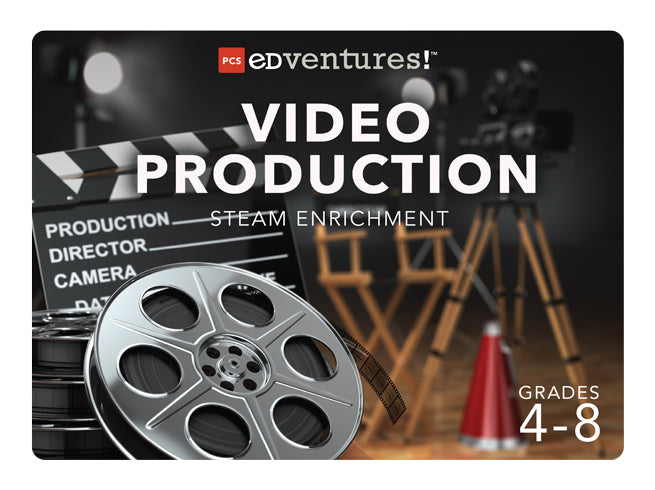
Video Production
Pricing Options:
- Complete Program (Materials + Curriculum): 415.00 USD
- Curriculum Print & Digital: 395.00 USD
Recommended Settings:
- Summer Camps
- Classrooms
- Out-of-School Time Programs
- Home Learning
Tech requirements:
- 6 compatible devices (1 per group of up to 5 students)
- The Canva video editing platform is compatible with Internet-connected tablets (Android or iPad), Chromebooks or computers.
Each Activity Includes:
- Schedule
- Opening & Closing Discussion
- Step-By-Step Activity Instructions
- Topic Background Information & Vocabulary
- Materials List
Curriculum Topics:
- Daily Lesson Titles
- Storytelling & Film
- Silent Films & Genres
- Interviews & Reporting
- Documentaries & Composition
- Storyboarding
- Intro to Filming
- Film Framing and Experimentation
- Film to Edit & B-Roll
- Intro to Editing
- Source & Sync Audio Files
- Final Edits & Credits
- Film Festival
Product Orientation:
- Half-hour free webinar orientation for purchases of $500+
- One-hour free webinar orientation for purchases of $1000+
- Additional training available for purchase
Complete Program Includes:
Video Production comes with all of the supplies needed for 30 students to complete 12 one-hour activities:
- Instructor Guide: 1
- Printed Student Pages: 30 sets
- #2 Pencils (12 Pack): 3
- Dry Erase Markers: 31
- Dry Erase Page Pockets: 31
- Gratnell Tray: 1
- Index Cards: 100
- Pencil Sharpeners: 12
- Sheets of White Paper: 31
- Access to the Digital Resource Portal
Curriculum Print & Digital Includes:
- Instructor Guide: 1
- Printed Student Pages: 30 sets
- Access to the Digital Resource Portal
Habits of Mind:
16 thinking habits developed by Art Costa and Bena Kallick to empower students to succeed in a 21st-century learning environment.
- Thinking and Communicating with Clarity and Precision
- Applying Past Knowledge to New Situations
- Engage effectively in a range of collaborative discussions
(one-on-one, in groups, and teacher-led) with diverse partners on grade
4-8 topics, texts, and issues, building on others' ideas and expressing
their own clearly. - Creating, Imagining, Innovating
- Thinking Interdependently
- Creating, Imagining, Innovating
21st Century Skills:
A set of widely-applicable abilities essential for success in the information age.
- Communication and Collaboration
- Information, Media, and Technology Literacy
- Social and Cross-Cultural Skills
- Applying Past Knowledge to New Situations
- Thinking Interdependently
- Creating, Imagining, Innovating
- Initiative and Self-Direction
- Flexibility and Adaptability
© 2019 Battelle for Kids. battelleforkids.org. All Rights Reserved. Battelle for Kids was not involved in the production of this product and does not endorse it.
Common Core State Standards for English Language Arts:
- CCSS.ELA-LITERACY.SL.4.1 Engage effectively in a range of collaborative discussions (one-on-one, in groups, and teacher-led) with diverse partners on grade 4 topics and texts, building on others’ ideas and expressing their own clearly.
- CCSS.ELA-LITERACY.SL.8.1 Engage effectively in a range of collaborative discussions (one-on-one, in groups, and teacher-led) with diverse partners on grade 4-8 topics, texts, and issues, building on others' ideas and expressing their own clearly.
- CCSS.ELA-LITERACY.RL.4.2 Determine a theme of a story, drama, or poem from details in the text; summarize the text.
- CCSS.ELA-LITERACY.W.4.3 Write narratives to develop real or imagined experiences or events using effective technique, descriptive details, and clear event sequences.
- CCSS.ELA-LITERACY.W.4.3.A Orient the reader by establishing a situation and introducing a narrator and/or characters; organize an event sequence that unfolds naturally.
- CCSS.ELA-LITERACY.W.4.3.B Use dialogue and description to develop experiences and events or show the responses of characters to situations.
- CCSS.ELA-LITERACY.SL.4.4 Report on a topic or text, tell a story, or recount an experience in an organized manner, using appropriate facts and relevant, descriptive details to support main ideas or themes; speak clearly at an understandable pace.
- CCSS.ELA-LITERACY.SL.4.5 Add audio recordings and visual displays to presentations when appropriate to enhance the development of main ideas or themes.
- CCSS.ELA-LITERACY.SL.4.6 Differentiate between contexts that call for formal English (e.g., presenting ideas) and situations where informal discourse is appropriate (e.g., small-group discussion); use formal English when appropriate to task and situation.
- CCSS.ELA-LITERACY.SL.8.1.C Pose questions that connect the ideas of several speakers and respond to others' questions and comments with relevant evidence, observations, and ideas.
- CSS.ELA-LITERACY.RL.8.2 Determine a theme or central idea of a text and analyze its development over the course of the text, including its relationship to the characters, setting, and plot; provide an objective summary of the text.
- CCSS.ELA-LITERACY.W.8.3 Write narratives to develop real or imagined experiences or events using effective technique, relevant descriptive details, and well-structured event sequences.
- CCSS.ELA-LITERACY.W.8.3.A Engage and orient the reader by establishing a context and point of view and introducing a narrator and/or characters; organize an event sequence that unfolds naturally and logically.
- CCSS.ELA-LITERACY.W.8.3.B Use narrative techniques, such as dialogue, pacing, description, and reflection, to develop experiences, events, and/or characters.
- CCSS.ELA-LITERACY.SL.8.4 Present claims and findings, emphasizing salient points in a focused, coherent manner with relevant evidence, sound valid reasoning, and well-chosen details; use appropriate eye contact, adequate volume, and clear pronunciation.
- CCSS.ELA-LITERACY.SL.8.5 Integrate multimedia and visual displays into presentations to clarify information, strengthen claims and evidence, and add interest.
- CCSS.ELA-LITERACY.SL.8.6 Adapt speech to a variety of contexts and tasks, demonstrating command of formal English when indicated or appropriate.
Common Core State Standards Initiative © Copyright 2010. National Governors Association Center for Best Practices and Council of Chief State School Officers. All rights reserved.
Dahlton Grover
Dahlton Grover was the previous Curriculum and Content Coordinator for PCS Edventures. Ms. Grover received her B.A. in Global Studies from the University of California,Santa Barbara in 2013. Following her education at UCSB she pursued a 200 hour Yoga Alliance certified yoga teacher training program in San Luis Obispo, CA, after which she returned home to Boise, ID.
Ms. Grover has extensive experience in writing, sales and marketing and her Global Studies background fuels her passion to change the face
of education worldwide. In addition, Ms. Grover was an original PCS Edventures student, as she attended their preschool at a young age and grew up around their curriculum and technology for many years. Because of her experience, Ms. Grover brings a unique student perspective to the production of this curriculum.






